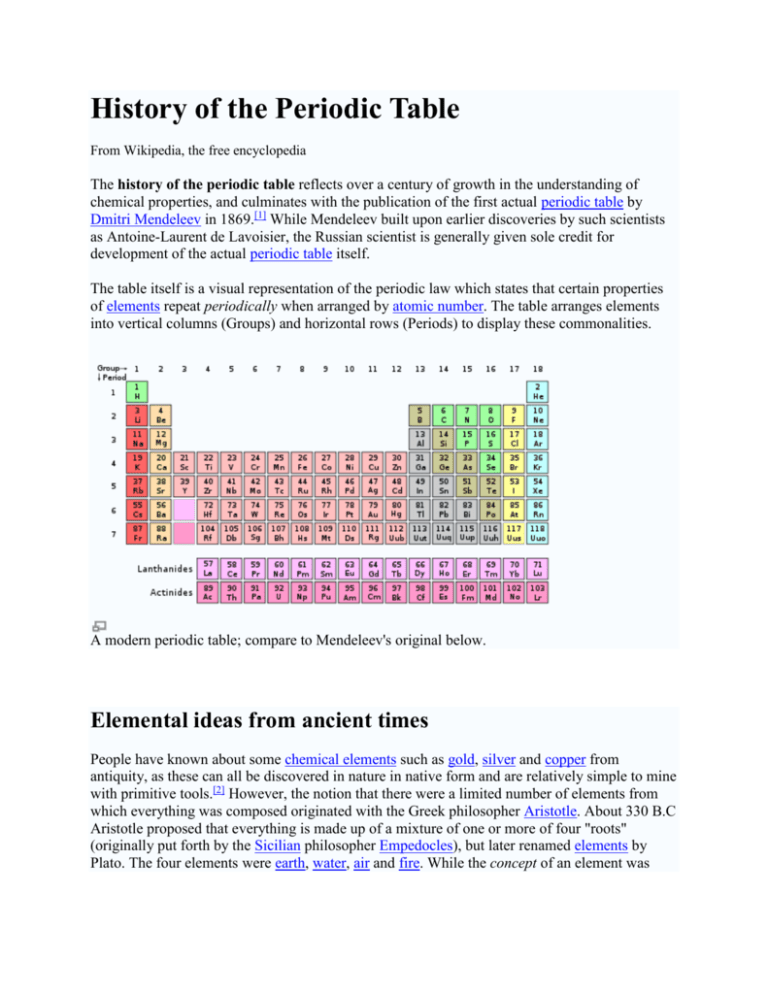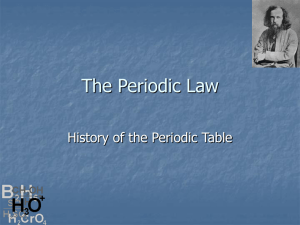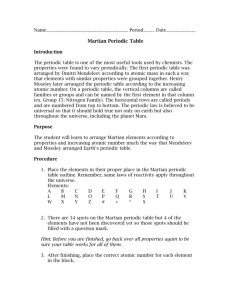History of Periodic Table
advertisement

History of the Periodic Table From Wikipedia, the free encyclopedia The history of the periodic table reflects over a century of growth in the understanding of chemical properties, and culminates with the publication of the first actual periodic table by Dmitri Mendeleev in 1869.[1] While Mendeleev built upon earlier discoveries by such scientists as Antoine-Laurent de Lavoisier, the Russian scientist is generally given sole credit for development of the actual periodic table itself. The table itself is a visual representation of the periodic law which states that certain properties of elements repeat periodically when arranged by atomic number. The table arranges elements into vertical columns (Groups) and horizontal rows (Periods) to display these commonalities. A modern periodic table; compare to Mendeleev's original below. Elemental ideas from ancient times People have known about some chemical elements such as gold, silver and copper from antiquity, as these can all be discovered in nature in native form and are relatively simple to mine with primitive tools.[2] However, the notion that there were a limited number of elements from which everything was composed originated with the Greek philosopher Aristotle. About 330 B.C Aristotle proposed that everything is made up of a mixture of one or more of four "roots" (originally put forth by the Sicilian philosopher Empedocles), but later renamed elements by Plato. The four elements were earth, water, air and fire. While the concept of an element was thus introduced, Aristotle's and Plato's ideas did nothing to advance the understanding of the nature of matter. Age of Enlightenment Hennig Brand was the first person recorded to have discovered a new element. Brand was a bankrupt German merchant who was trying to discover the Philosopher's Stone — a mythical object that was supposed to turn inexpensive base metals into gold. He experimented with distilling human urine until in 1649[3] he finally obtained a glowing white substance which he named phosphorus. He kept his discovery secret, until 1680 when Robert Boyle rediscovered it and it became public. This and related discoveries raised the question of what it means for a substance to be an "element". In 1661 Boyle defined an element as a substance that cannot be broken down into a simpler substance by a chemical reaction. This simple definition actually served for nearly 300 years (until the development of the notion of subatomic particles), and even today is taught in introductory chemistry classes. Antoine-Laurent de Lavoisier Antoine Laurent de Lavoisier Lavoisier's Traité Élémentaire de Chimie (Elementary Treatise of Chemistry, 1789, translated into English by Robert Kerr) is considered to be the first modern chemical textbook. It contained a list of elements, or substances that could not be broken down further, which included oxygen, nitrogen, hydrogen, phosphorus, mercury, zinc, and sulfur. It also forms the basis for the modern list of elements. His list, however, also included light and caloric, which he believed to be material substances. While many leading chemists of the time refused to believe Lavoisier's new revelations, the Elementary Treatise was written well enough to convince the younger generation. However, as Lavoisier's descriptions only classified elements into metals and non-metals, it fell short of a complete analysis. Johann Wolfgang Döbereiner In 1817, Johann Wolfgang Döbereiner began to formulate one of the earliest attempts to classify the elements. He found that some elements formed groups of three with related properties. He termed these groups "triads". Some triads classified by Döbereiner: 1. 2. 3. 4. chlorine, bromine, and iodine calcium, strontium, and barium sulfur, selenium, and tellurium lithium, sodium, and potassium In all of the triads, the atomic weight of the second element was almost exactly the average of the atomic weights of the first and third element.[4] Classifying Elements By 1869[3], a total of 63[3] elements had been discovered. As the number of known elements grew, scientists began to recognize patterns in the way chemicals reacted and began to devise ways to classify the elements. Alexandre-Emile Béguyer de Chancourtois Alexandre-Emile Béguyer de Chancourtois, a French geologist, was the first person to notice the periodicity of the elements — similar elements seem to occur at regular intervals when they are ordered by their atomic weights. He devised an early form of periodic table, which he called the telluric helix. With the elements arranged in a spiral on a cylinder by order of increasing atomic weight, de Chancourtois saw that elements with similar properties lined up vertically. His chart included some ions and compounds in addition to elements. His paper was published in 1862, but used geological rather than chemical terms and did not include a diagram; as a result, it received little attention until the work of Dmitri Mendeleev.[5] John Newlands John Newlands was an English chemist who in 1865 classified[6] the 56 elements that had been discovered at the time into 11 groups which were based on similar physical properties. Newlands noted that many pairs of similar elements existed which differed by some multiple of eight in atomic weight. However, his law of octaves, likening this periodicity of eights to the musical scale, was ridiculed by his contemporaries. It was not until the following century, with Gilbert N. Lewis' valence bond theory (1916) and Irving Langmuir's octet theory of chemical bonding[7][8] (1919) that the importance of the periodicity of eight would be accepted. Mendeleev Dmitri Ivanovich Mendeleev Dmitri Mendeleev, a Siberian-born Russian chemist, was the first scientist to make a periodic table much like the one we use today. Mendeleev arranged the elements in a table ordered by atomic weight, corresponding to relative molar mass as defined today. It is sometimes said that he played "chemical solitaire" on long train rides using cards with various facts of known elements.[9] On March 6, 1869, a formal presentation was made to the Russian Chemical Society, entitled The Dependence Between the Properties of the Atomic Weights of the Elements. His table was published in an obscure Russian journal but quickly republished in a German journal, Zeitschrift für Chemie (Eng., "Chemistry Magazine"), in 1869. It stated: 1. The elements, if arranged according to their atomic weights, exhibit an apparent periodicity of properties. 2. Elements which are similar as regards to their chemical properties have atomic weights which are either of nearly the same value (e.g., Pt, Ir, Os) or which increase regularly (e.g., K, Rb, Cs). 3. The arrangement of the elements, or of groups of elements in the order of their atomic weights, corresponds to their so-called valencies, as well as, to some extent, to their distinctive chemical properties; as is apparent among other series in that of Li, Be, Ba, C, N, O, and Sn. 4. The elements which are the most widely diffused have small atomic weights. 5. The magnitude of the atomic weight determines the character of the element, just as the magnitude of the molecule determines the character of a compound body. 6. We must expect the discovery of many yet unknown elements–for example, elements analogous to aluminium and silicon–whose atomic weight would be between 65 and 75. 7. The atomic weight of an element may sometimes be amended by a knowledge of those of its contiguous elements. Thus the atomic weight of tellurium must lie between 123 and 126, and cannot be 128. (This was based on the position of tellurium between antimony and iodine whose atomic weight is 127. However Moseley later explained the position of these elements without revising the atomic weight values — see below.) 8. Certain characteristic properties of elements can be foretold from their atomic weights. This version of Mendeleev's periodic table from 1891. It is lacking the noble gases Scientific benefits of Mendeleev's table Mendeleev predicted the discovery of other elements and left space for these new elements, namely eka-silicon (germanium), eka-aluminium (gallium), and eka-boron (scandium). Thus, there was no disturbance in the periodic table. He pointed out that some of the then current atomic weights were incorrect. He provided for variance from atomic weight order. Shortcomings of Mendeleev's table His table did not include any of the noble gases, which were discovered later. These were added by Sir William Ramsay as Group 0, without any disturbance to the basic concept of the periodic table. There was no place for the isotopes of the various elements, which were discovered later. Lothar Meyer Unknown to Mendeleev, Lothar Meyer was also working on a periodic table. Although his work was published in 1864, and was done independently of Mendeleev, few historians regard him as an equal co-creator of the periodic table. For one thing, Meyer's table only included 28 elements. Furthermore, Meyer classified elements not by atomic weight, but by valence alone. Finally, Meyer never came to the idea of predicting new elements and correcting atomic weights. Only a few months after Mendeleev published his periodic table of all known elements (and predicted several new elements to complete the table, plus some corrected atomic weights), Meyer published a virtually identical table. While a few people consider Meyer and Mendeleev the cocreators of the periodic table, most agree that, by itself, Mendeleev's accurate prediction of the qualities of the undiscovered elements lands him the larger share of credit. In any case, at the time Mendeleev's predictions greatly impressed his contemporaries and were eventually found to be correct. An English chemist, William Odling, also drew up a table that is remarkably similar to that of Mendeleev in 1864. Refinements to the periodic table Henry Moseley In 1914 Henry Moseley found a relationship between an element's X-ray wavelength and its atomic number (Z), and therefore resequenced the table by nuclear charge rather than atomic weight. Before this discovery, atomic numbers were just sequential numbers based on an element's atomic weight. Moseley's discovery showed that atomic numbers had an experimentally measurable basis. Thus Moseley placed argon (Z=18) before potassium (Z=19) based on their X-ray wavelengths, despite the fact that argon has a greater atomic weight (39.9) than potassium (39.1). The new order agrees with the chemical properties of these elements, since argon is a noble gas and potassium an alkali metal. Similarly, Moseley placed cobalt before nickel, and was able to explain that tellurium occurs before iodine without revising the experimental atomic weight of tellurium (127.6) as proposed by Mendeleev. Moseley's research also showed that there were gaps in his table at atomic numbers 43 and 61 which are now known to be Technetium and Promethium, respectively, both radioactive and not naturally occurring. Following in the footsteps of Dmitri Mendeleev, Henry Moseley also predicted new elements. Glenn T. Seaborg During his Manhattan Project research in 1943 Glenn T. Seaborg experienced unexpected difficulty isolating Americium (95) and Curium (96). He began wondering if these elements more properly belonged to a different series which would explain why the expected chemical properties of the new elements were different. In 1945, he went against the advice of colleagues and proposed a significant change to Mendeleev's table: the actinoid series (previously called the actinide series). Seaborg's actinide concept of heavy element electronic structure, predicting that the actinides form a transition series analogous to the rare earth series of lanthanide elements, is now well accepted in the scientific community and included in all standard configurations of the periodic table. The actinide series are the second row of the f-block (5f series) and comprise the elements from Actinium to Lawrencium. Seaborg's subsequent elaborations of the actinide concept theorized a series of superheavy elements in a transactinide series comprising elements 104 through 121 and a superactinide series inclusive of elements 122 through 153. The periodic table as a cultural icon A periodic table mounted on a classroom wall Throughout the 20th century, the periodic table grew in ubiquity. Its presence on a classroom wall tells the movie-viewing audience that they are viewing a science classroom. It is often provided to students taking standardized tests as a necessary tool to complete chemical problems. In 1998, a 35-by-65-foot (11 by 20 m) periodic table at the Science Museum of Virginia was declared the world's largest periodic table by the Guinness Book of World Records.[10] References 1. IUPAC article on periodic table 2. Scerri, E. R. (2006). The Periodic Table: Its Story and Its Significance; New York City, New York; Oxford University Press. 3. "A Brief History of the Development of Periodic Table". http://www.wou.edu/las/physci/ch412/perhist.htm. 4. Leicester, Henry M. (1971). The Historical Background of Chemistry; New York City, New York; Dover Publications. 5. Annales des Mines history page. 6. in a letter published in the Chemical News in February 1863, according to the Notable Names Data Base 7. Irving Langmuir, “The Structure of Atoms and the Octet Theory of Valence”, Proceedings of the National Academy of Science, Vol. V, 252, Letters (1919) - online at [1] 8. Irving Langmuir, “The Arrangement of Electrons in Atoms and Molecules”, Journal of the American Chemical Society, Vol. 41, No, 6, pg. 868 (June 1919) - beginning and ending of the paper are transcribed online at [2]; the middle is missing 9. Physical Science, Holt Rinehart & Winston (January 2004), page 302 ISBN 0-03073168-2 10. "Richmond in the Record Books". August 18, 2004. http://www.richmond.com/museums-galleries/6300. External links History of the Development of the Periodic Table of Elements Development of the periodic table Classification of the elements The path to the periodic table Web page listing several scholarly and semi-popular articles on various aspects of the periodic system and underlying theoretical concepts. Some are dowloadable! Periodic Table Database Retrieved from "http://en.wikipedia.org/wiki/History_of_the_periodic_table" Categories: History of chemistry | History of physics | Periodic table | History of chemical elements Questions Related to the Reading of “History of Periodic Table” 1. 2. 3. 4. 5. Who was given the sole credit for development of the Periodic Table? What is the Periodic Table? What are the Periods and Groups? Who was the first one to use the term “element” What was Boyle’s definition of element that is still used in introductory chemistry classes today? 6. Who wrote the first modern chemical textbook in which the elements were merely classified as metals and nonmetals? 7. Who was among the first scientists to attempt at organizing elements? What was the “triads”? 8. Who was John Newlands? And what did he do? 9. What property did Mendeleev use to arrange his elements? 10. What are the scientific benefits of Mendeleev’s table? 11. What are the shortcomings of Mendeleev’s table? 12. Who was Lothar Meyer? And what did he do? Why was he not put into the same historical place as Mendeleev? 13. What was the major refinement to Mendeleev’s Periodic Table by Henry Moseley? 14. What was the major contribution to the Modern Periodic Table by Glenn Seaborg?







